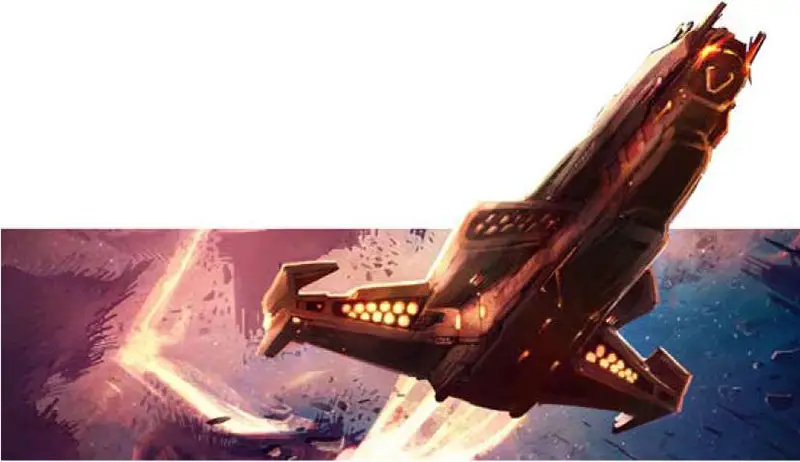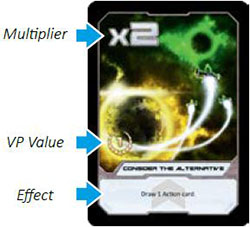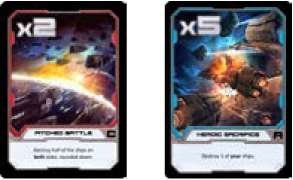
Attacking is moving your ships to a planet with another player's ships, using a Skirmish, Advance, or Concentrate action.
The only way to move your ships to a planet with another player's ships is by attacking.

Attack results in a battle. The player who is currently resolving the action is the attacker and the other player who has ships at the planet is the defender.

Tactics Cards
There are three types of Tactics cards - Basic Tactics, Hero Tactics, and Advanced Tactics. For the purpose of resolving a battle , they work in exactly the same way.
Every Tactics card has a multiplier and a card text. In most cases, the higher the multiplier, the higher the likelihood of winning the battle, when playing that card.
At the same time, in most cases, the lower the multiplier, the more powerful is the effect in the card's text.

Advanced Tactics and Hero Tactics cards (with a chevron watermark ) are worth 1VP each at the end of the game (see page 5). You can use a Promote action to add new Tactics to your Tactics deck.
Resolve a battle by following these 5 steps:
-
Draw Cards
Both the attacker and the defender simultaneously draw 2 Tactics cards from their respective Tactics decks.
If, at any point, your Tactics deck runs out of cards, shuffle your discarded Tactics cards to form a new Tactics deck.
-
Play Cards
Both the attacker and the defender choose one Tactics card from their hand and play it face down in front of them.
Reveal the played cards and then discard the card not chosen face up onto the discard pile.

The Red player is attacking the Blue player. The Red player plays a "Pitched Battle" (x2) and the Blue player plays a "Heroic Sacrifice" (x5).
-
Determine the winner
Multiply the number of each player's ships in the battle by the multiplier on their Tactics card.
If you play a Tactics card with xO multiplier, the resulting total strength of your ships is 0, regardless of how many ships you have.
The player with the highest total strength wins the battle. In case of a tie, the attacking player wins.
The winner of the battle is already decided at this point. You may win a battle even if your entire fleet is later destroyed due to a card's effect.

The Red player is attacking the Blue player with 6 ships. The Blue player only has 2 ships. After applying the multipliers, the Red player wins, 12 to 10.
-
Resolve the effects
Resolve the text of all played cards. Then both players place their cards into their corresponding discard pile.
First resolve the text on cards that cancel the text of other cards.
Two cards with "cancel" effect cancel each other's entire text.
For cards that destroy ships, resolve them in such an order to destroy as many ships as possible.
 Technology cards with a crossed swords trigger icon, such as "Countermeasures", are triggered during the battle, but only if you are a participant of that battle.
Technology cards with a crossed swords trigger icon, such as "Countermeasures", are triggered during the battle, but only if you are a participant of that battle.

Cards that destroy ships must be resolved in such an order to destroy as many ships as possible, so "Pitched battle" must be resolved first. Half of the ships, rounded down, are destroyed on both sides.
The Red player loses 2 ships and the Blue player loses 1. Then Heroic sacrifice is resolved and the Blue player loses his last remaining ship. Destroyed ships are returned to the corresponding player's supply. The Red player occupies the Volcanic planet.
-
Losing side withdraws
The defeated player must withdraw from the planet (even if the winning player has no more ships left on the planet).
If the defender loses the battle, their ships must withdraw to the nearest planet where they already have an Outpost, a Colony, or a ship. Warpgate counts as a planet with a Colony for this purpose.
Defender may not withdraw to a planet (or planets) where the attacker attacked from, or to any planet that contains enemy ships.
If there are multiple valid planets for the defender to withdraw at the same range, the attacker chooses which one of those planets the defender withdraws to.
If the attacker loses the battle, their ships always withdraw back to the planet they were attacking from (or planets, in case of Concentrate).
If the attacker was using a Concentrate action, and lost, the defender splits the surviving attacking ships between the two planets where the attack came from as they wish (including sending all of them to only one of those planets).
After the losing side withdraws, the battle is over.

Example 1: The Blue player is attacking the Red player's ship on a Jungle planet. If the Blue player wins the battle, the Red player will have to withdraw. The nearest valid planet is the Arctic planet. While the Volcanic planet is within the same range, it has neither red ships, nor a red Colony, nor a red Outpost.

Example 2: The Blue player is attacking the Red player's ship on a Desert planet. If the Blue playerwins the battle, the Red player will have to withdraw. There are two valid planets for the Red player to withdraw. Since there is a choice, the winning player (Blue) gets to decide where the losing player (Red) must withdraw.

Example 3: The Blue player is attacking the Red player's ship on an Arctic planet. If the Blue player wins the battle, the Red player will have to withdraw. There are no valid planets in range (Red player has no ships, noran Outpost, nor a Colony on the Oceanic planet), so Red player must withdraw to their Warpgate.

The Red player is attacking the Blue player with 3 ships and plays "Heavy resistance", The Blue player plays "All or Nothing". The Blue player wins with 6 total strength to the Red player's 3.

This was a gamble on the Blue player's part. If the Red player would have played a card with a multiplier ofx2 or higher, Blue player would likely have lost all of their ships due to "All or nothing". The gamble paid off, however, and Blue player only loses 1 ship to "Heavy resistance".

The Red player has lost and must withdraw back to the planet they were attacking from (even though it has no Red player's Outpost, Colony, or ships), after destroy! ng a single blue ship.
Continue Reading